The Enigmatic Mosaics of Hagia Sophia
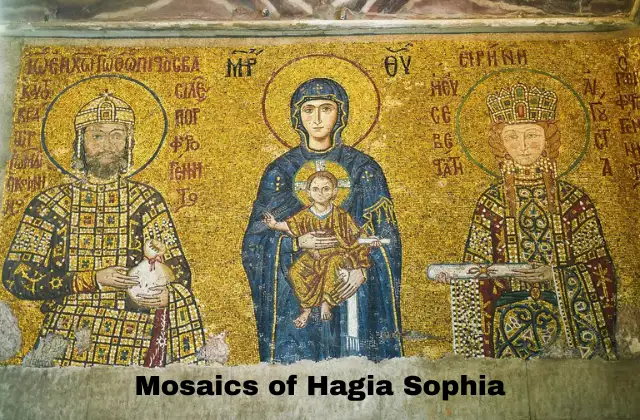
Mosaics of Hagia Sophia is a captivating phrase that immediately draws one into the heart of Istanbul’s historical and artistic treasure.
This architectural marvel, once a cathedral, then a mosque, and even a museum at one point, bears witness to the intricate tapestry of religious, artistic, and historical transformations that have unfolded in the city.
Within its hallowed walls lie an extraordinary collection of mosaics, each a poignant relic of a bygone era that refuses to fade into oblivion. These mosaics transcend mere artistic expression; they are vibrant narratives of the rise and fall of empires, the evolution of faiths, and the ebb and flow of civilizations.
Join us on a journey into the mesmerizing realm of the Mosaics of Hagia Sophia, a testament to Byzantine mastery and the enduring influences of the Ottoman era.
The Odyssey of Hagia Sophia
Constructed in 537 AD, Hagia Sophia was a beacon of Christianity for nine centuries. Nevertheless, its interiors have always been a subject of contention, particularly the intricate mosaics adorning its walls.
After the Ottoman Empire seized control in 1453, the building underwent another transformation—into a mosque, a function it would serve for about half a millennium.
The secular Turkey of the 1930s turned it into a museum, only for it to revert to a mosque in July 2020.
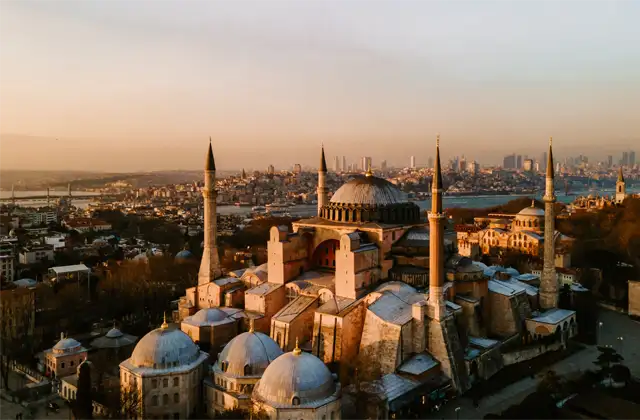
The Uncertain Fate of Timeless Art
Hagia Sophia’s change in status raises significant questions regarding its mosaics. Islamic traditions generally prohibit figural representations in prayer spaces, but what happens to art that existed long before the building’s Islamic reincarnation?
During the Ottoman era, the mosaics were concealed beneath layers of plaster. It was only in the 20th century, primarily under the efforts led by Thomas Whittemore and the Byzantine Institute of America, that these forgotten masterpieces were painstakingly revealed again.
As of 2021, the ground-floor mosaics remain accessible, though the ones on the upper floor are currently shielded from the public eye due to restoration efforts.
Mosaics of Hagia Sophia
Let’s take a detailed look at the Hagia Sophia mosaics and get acquainted with these works of art.
The Guardians Above: The Seraphim Angels
The mosaics of Seraphim Angels, gracing the four corners of Hagia Sophia’s magnificent dome, hold a special place in the annals of Byzantine history and religious art.
These celestial beings were not just ornamental decorations; they were deeply woven into the spiritual fabric of the city of Constantinople, now known as Istanbul.
Legends and beliefs surrounding these Seraphim Angels suggest that they played a pivotal role as celestial protectors, guarding the Byzantine capital with divine fervor.
Throughout its long and tumultuous history, Constantinople faced countless threats and sieges, with armies and empires seeking to conquer this prized jewel of the Byzantine Empire. Yet, the city seemed invincible, and many attributed its resilience to the watchful presence of the Seraphim Angels within Hagia Sophia.
These angelic figures, often depicted with six wings, radiated a sense of heavenly authority. They were seen as intermediaries between the earthly realm and the divine, their benevolent presence believed to shield the city and its people from harm. The Seraphim Angels embodied the spiritual essence of Hagia Sophia, enhancing its sanctity and mystique.
The mosaics themselves were not only a testament to the Byzantine mastery of the craft but also a reflection of the city’s enduring faith and determination. The intricate details and vivid colors used in the mosaics conveyed a sense of ethereal beauty, further elevating the spiritual experience of those who visited Hagia Sophia.
As Constantinople stood at the crossroads of cultures and empires, the Seraphim Angels’ significance transcended religious boundaries. They symbolized the city’s rich tapestry of faiths, uniting Orthodox Christianity and the Byzantine Empire.
Their presence in Hagia Sophia also reflected the multicultural and diverse nature of the city, which served as a melting pot of different civilizations.
Over time, as Constantinople fell to the Ottoman Empire and Hagia Sophia underwent a transformation into a mosque, the Seraphim Angels remained an integral part of the building’s identity. They continued to inspire awe and reverence among the faithful, albeit within a different religious context.
While Hagia Sophia stands as a mosque today, the Angels of Seraphim mosaics continue to fascinate visitors from all over the world. They serve as a poignant reminder of the city’s enduring spirit and the role that art, faith, and history play in shaping the city’s destiny. The mosaics remain not only stunning examples of artistic achievement but also a testament to the lasting legacy of the Angels of the Seraphim as the heavenly guardians of a city that witnessed the rise and fall of empires and the power of faith.
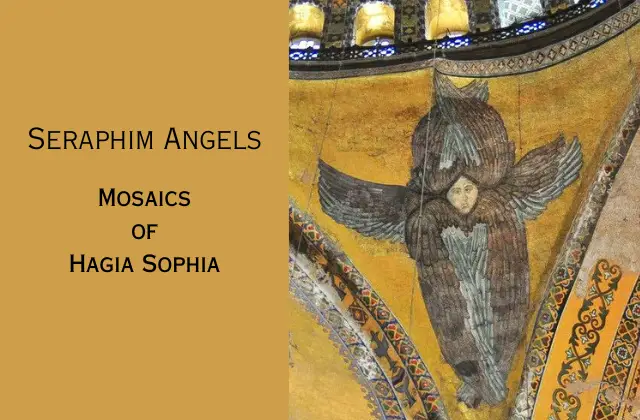
Earthly Monarchs and Heavenly Rulers: The Mosaic of Emperor Leo VI
Amidst the rich tapestry of mosaics that adorn the venerable Hagia Sophia, one of the most captivating and enigmatic is the mosaic of Emperor Leo VI.
This intricate artwork, located above the imperial gate, offers a profound glimpse into the life and faith of a Byzantine ruler whose reign was marked by both worldly accomplishments and personal controversies.
Emperor Leo VI the Wise is a figure of historical intrigue. Ascending to the Byzantine throne in the late 9th century, his reign was characterized by intellectual pursuits, legal reforms, and a deep engagement with matters of faith.
However, it was his multiple marriages that cast a shadow of controversy over his rule. Leo VI’s marital history was a complex web of ecclesiastical objections and political alliances, making him a ruler whose personal life often overshadowed his accomplishments.
The mosaic dedicated to this monarch captures a pivotal moment in his life. Emperor Leo VI is depicted in a posture of humility and devotion, kneeling in prayer before an image of Jesus Christ.
This act of supplication is profoundly symbolic, as it represents the emperor’s earnest desire for divine guidance and forgiveness, perhaps as a response to the challenges he faced during his reign.
Flanking Emperor Leo VI in the mosaic are two other significant figures from Christian theology. To his left is the Blessed Virgin Mary, known as the Theotokos or Mother of God in Orthodox Christianity.
She is a symbol of purity and maternal love, offering her intercession on behalf of the emperor. To his right stands the Archangel Gabriel, the heavenly messenger who announced to Mary that she would conceive and give birth to Jesus. The presence of Gabriel underscores the divine significance of the moment and suggests that the emperor sought heavenly guidance and protection.
This mosaic serves as a testament to the complex interplay between faith and power in the Byzantine Empire. Leo VI, despite his worldly authority, acknowledges his dependence on the divine. His act of prayer signifies a desire for spiritual clarity and the hope of divine favor.
Furthermore, the placement of this mosaic above the imperial gate carries deep symbolism. It welcomes both the emperor and his subjects into the sacred space of Hagia Sophia, emphasizing the connection between earthly rulers and their heavenly responsibilities. It is a reminder that even the most powerful of monarchs must bow before the ultimate authority of the divine.
Today, the mosaic of Emperor Leo VI continues to captivate visitors to Hagia Sophia, inviting them to contemplate the complexities of leadership, faith, and human frailty. It stands as a striking example of how art and religious devotion converged in the Byzantine Empire, offering a window into the soul of a ruler who, despite his worldly stature, sought solace and guidance in the presence of the divine.
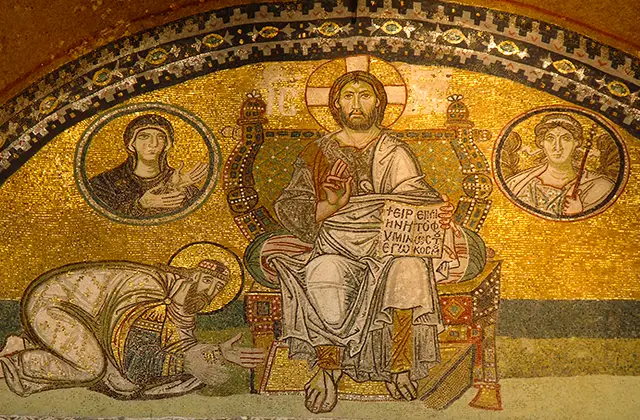
The Virgin and the Throne
This captivating mosaic, situated in the apse of Hagia Sophia, portrays the Virgin Mary tenderly cradling the infant Jesus. Its creation, emerging from the ashes of Byzantine Iconoclasm in the latter part of the 9th century, carries profound significance that transcends mere artistry.
The mosaic’s genesis lies in a turbulent era of Byzantine history, marked by the Iconoclastic Controversy. This enduring conflict spanned centuries and was rooted in the interpretation of religious doctrine.
The Iconoclasts, staunch proponents of a strict interpretation, sought to eradicate religious icons and mosaics, convinced that such images violated the commandment against graven images. However, their opponents, known as the Iconophiles, ardently championed the veneration of religious images, arguing that they served as conduits for the divine presence and the teachings of Christianity.
The mosaic of the Virgin and the infant Jesus stands as a testament to the unwavering faith and tenacity of the Iconophiles. It embodies their successful campaign against the Iconoclasts, marking a resounding triumph of faith over religious dogma. Beyond its historical context, this mosaic holds a deep wellspring of symbolism and spiritual significance.
In the mosaic, the Virgin Mary is depicted with serene grace, cradling the infant Jesus on her lap. The child’s outstretched hand, as if imparting a blessing, and the mutual gaze of mother and son radiate an aura of divine love and tenderness. Mary sits upon a majestic throne, known as the Cathedra, which symbolizes her exalted status as the Mother of God and the Queen of Heaven.
This mosaic encapsulates the pivotal shift in the Byzantine Empire—a transition from iconoclasm to iconophilia. It heralds the return of religious art and the veneration of sacred images, announcing that these forms of expression were not only surviving but thriving.
The presence of this mosaic in Hagia Sophia signifies that religious art had not just persevered; it had emerged stronger and more triumphant than ever. It rekindled the belief that artistic representation could be a conduit for the divine, a concept that continues to reverberate throughout the world of religious art.
Today, as visitors from all corners of the globe stand before the mosaic of the Virgin and the infant Jesus in Hagia Sophia, they are not merely beholding a work of art. They are bearing witness to a testament of faith’s enduring power, the indomitable resilience of artistic expression, and the unfaltering conviction that transcended iconoclastic opposition.
This mosaic is a reminder that the artistic and the spiritual have the capacity to transcend the tumultuous tides of history and etch an indelible mark on the human soul.
The Virgin and the infant Jesus in the apse of Hagia Sophia continue to inspire awe and reverence. They bear witness to the enduring legacy of those who defended the use of religious images and the profound connection between faith and art in the Byzantine Empire.
In this mosaic, a timeless message resounds through the ages, inviting all who gaze upon it to contemplate the profound interplay between the divine, the artistic, and the human spirit.
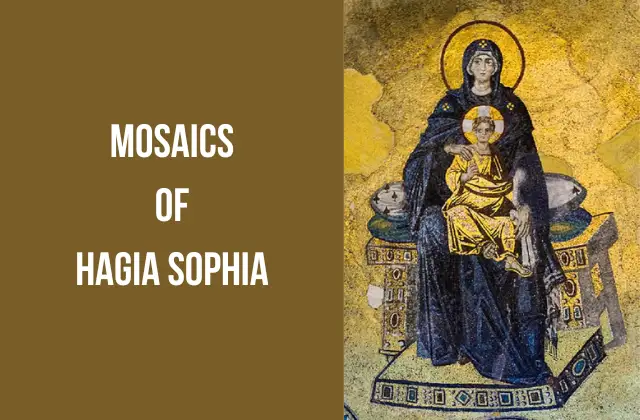
Emperors of Renewal: The Legacy of Justinian and Constantine
Nestled near the southern gate of Hagia Sophia, a captivating mosaic unfurls a scene that encapsulates the monumental contributions of two Byzantine emperors—Justinian and Constantine. In this breathtaking artwork, they are depicted in a posture of profound reverence, offering their most enduring legacies to the Virgin and Child—a symbolic gesture of devotion and gratitude.
Emperor Constantine, a pivotal figure in the history of Christianity and the Byzantine Empire, is celebrated for his groundbreaking Edict of Milan. This monumental decree, issued in the early 4th century, marked a watershed moment in the Roman world.
It heralded an era of religious freedom, effectively ending the persecution of Christians and allowing them to practice their faith openly. Constantine’s vision of a united, Christian Roman Empire laid the foundations for the Byzantine Empire and, ultimately, the development of Eastern Orthodox Christianity.
Emperor Justinian, who reigned during the 6th century, is renowned for his audacious ambition to restore the Roman Empire’s former glory.
His reign marked a period of significant cultural and architectural achievements. Foremost among these accomplishments is the resplendent Hagia Sophia, a feat of architectural ingenuity that redefined the possibilities of construction.
Justinian’s determination to reclaim the Western Roman territories led to the reconquest of parts of Italy and North Africa, albeit briefly. His legal reforms, encapsulated in the Justinian Code, remain a cornerstone of modern legal systems and jurisprudence.
The mosaic featuring Justinian and Constantine paying homage to the Virgin and Child underscores the profound impact of these emperors on the Byzantine Empire and the world at large. It symbolizes their commitment to both their faith and their empire, intertwining the spiritual and the earthly realms.
The offering of Hagia Sophia and the city of Constantinople, represented in the mosaic, reflects the deep connection between religious devotion and imperial grandeur. These emperors recognized the transformative power of faith and believed in the divine providence that underpinned their reigns.
In the case of Constantine, his embrace of Christianity not only altered the religious landscape but also laid the groundwork for the enduring influence of Christianity in the Byzantine Empire and beyond. His legacy is synonymous with the fusion of faith and empire, and his visionary leadership reshaped the course of history.
For Justinian, the mosaic serves as a testament to his relentless pursuit of greatness. His construction of Hagia Sophia, a masterpiece that still awes visitors today, stands as an enduring symbol of his ambition to restore the Roman Empire’s former splendor and consolidate the Byzantine legacy.
As visitors to Hagia Sophia gaze upon this mosaic, they are transported back in time, witnessing a pivotal moment in the annals of Byzantine history. Justinian and Constantine immortalized in stone and color, continue to inspire awe and reflection, reminding us of the indelible mark that visionary leaders can leave on the world.
Their dedication to faith, empire, and the enduring legacy of Hagia Sophia beckons all to contemplate the intricate interplay of power, devotion, and artistic achievement that shaped the Byzantine Empire and the broader trajectory of human history.
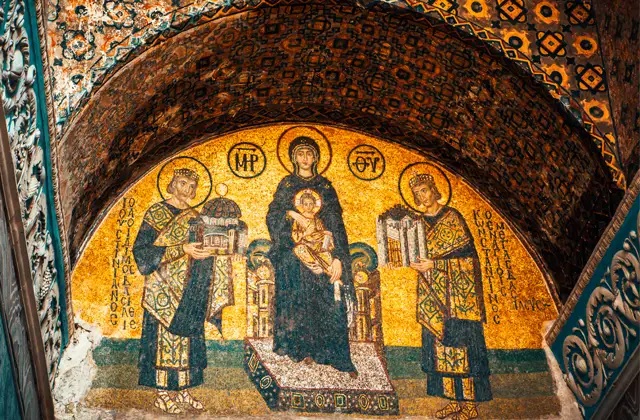
A Family Affair: John Komnenos II and Irene
Within the venerable Hagia Sophia, a mosaic of profound beauty and poignant significance graces the walls—a portrayal of Emperor John Komnenos II, his wife Irene, and their young son Alexios.
This mosaic is a remarkable blend of artistic brilliance and heartrending narrative, offering a glimpse into the deeply personal aspects of imperial life and the intertwining of faith and tragedy.
Emperor John Komnenos II, a prominent figure in the 12th-century Byzantine Empire, assumed the throne with a sense of duty and honor. His reign marked a period of relative stability and prosperity, and his contributions to the empire were considerable. However, it was not solely his political prowess that this mosaic seeks to convey.
Empress Irene, his wife, stands beside him in this artful depiction. Her presence serves as a testament to the essential role of women in the Byzantine court, as well as the significance of familial bonds in the life of an emperor. Irene was not merely a consort; she was a partner in matters of governance and faith, and this mosaic immortalizes her in that capacity.
But it is the presence of their young son, Alexios, that lends a poignant dimension to this artwork. The child’s cherubic visage and innocent gaze hint at the untold promise of his future.
Yet, history reveals that Alexios’s life was marked by tragedy, as he met an untimely demise, casting a shadow of sorrow over the Komnenos family.
The mosaic captures this familial trio in a moment of religious devotion. Emperor John Komnenos II, adorned in the regalia of his office, stands in an attitude of reverence before a religious icon. Empress Irene, her countenance exuding grace and piety, joins her husband in prayer. Young Alexios, though too young to fully comprehend the significance of the moment, is included in the act of devotion.
The composition of this mosaic serves to highlight the emperor’s commitment to his faith, an important aspect of Byzantine rule, where religious piety was closely intertwined with the exercise of imperial power.
The mosaic subtly underscores the significance of family in matters of faith and governance, emphasizing the emperor’s role as both a political leader and a spiritual figurehead.
However, it is impossible to view this mosaic without the knowledge of the tragic fate that awaited young Alexios. His inclusion in this scene, innocent and unknowing, lends a layer of melancholy to the artwork.
The mosaic becomes a poignant reminder of the ephemeral nature of life and the unpredictability of fate, even for those who occupy the highest echelons of power.
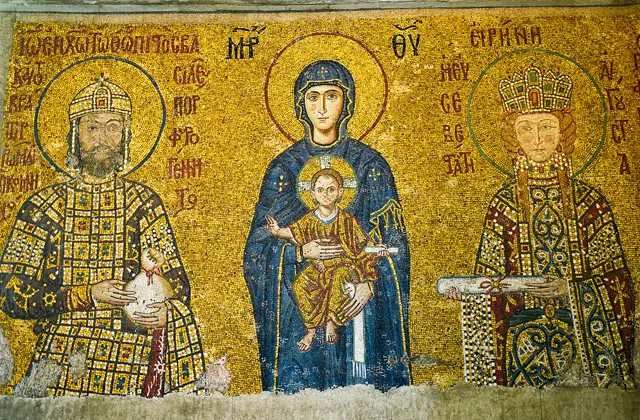
A Testament to Final Judgment: The Deesis Mosaic
High above the floors of Hagia Sophia, in the realm of celestial heights, resides a masterpiece of unparalleled significance—the Deesis Mosaic.
This mosaic, dating back to the 13th century, stands as both a pinnacle of Byzantine artistry and a profound expression of theological and spiritual themes. It is a testament to the enduring power of visual art to convey complex ideas and emotions.
At the heart of the Deesis Mosaic is the majestic figure of Christ Pantocrator. Enthroned in divine splendor, Christ gazes forth with an expression that encapsulates His role as the Almighty, the Ruler of All. His right hand is raised in a gesture of blessing, while His left hand holds the Holy Gospel, symbolizing divine wisdom and guidance.
Flanking Christ are two revered intercessors—the Virgin Mary and John the Baptist. They stand as intermediaries between humanity and the divine, pleading for mercy and forgiveness on behalf of all. Their postures convey a deep sense of supplication and devotion, as they turn towards Christ, their hearts filled with compassion for the plight of humanity.
The Deesis Mosaic is not merely a work of art; it is a theological statement of profound import. It symbolizes the final judgment, a moment when Christ, as Pantocrator (the Almighty), will decide the fate of all souls.
The Virgin Mary and John the Baptist, regarded with great reverence in the Christian tradition, serve as exemplars of intercession and compassionate intercession. They beseech Christ to show mercy to all who seek His grace, underscoring the central theme of redemption in Christian theology.
The mosaic also represents the culmination of Byzantine artistic achievements. The intricate details, vibrant colors, and emotive expressions on the faces of the figures demonstrate the mastery of Byzantine artisans.
It is a testament to their ability to convey complex theological concepts through visual art, making the spiritual tangible and accessible.
As visitors to Hagia Sophia gaze upon the Deesis Mosaic, they are transported into a profound contemplation of faith, redemption, and the final judgment. It is a moment frozen in time, where the divine and the human intersect, inviting all who behold it to reflect on the enduring questions of salvation and mercy.
The Deesis Mosaic serves as a reminder that art, at its zenith, has the power to transcend time and culture, touching the depths of the human spirit and echoing the eternal truths that define our existence.
In this mosaic, we find not just an expression of Byzantine artistry but a profound testament to the enduring quest for meaning and salvation that unites humanity across the ages.
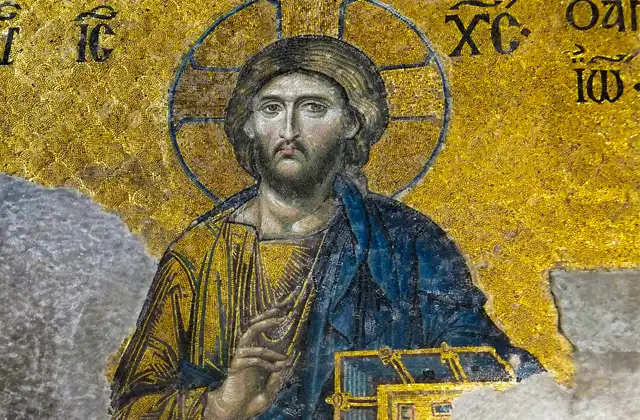
Constantine IX and Zoe: A Mosaic of Love and Intrigue
Amidst the resplendent mosaics that grace the walls of Hagia Sophia, a captivating tableau unfolds—a depiction of Emperor Constantine IX Monomachos and Empress Zoe.
This mosaic, while radiating the opulence and grandeur of Byzantine artistry, conceals beneath its surface a tale of love, politics, and the subtle hand of history.
Emperor Constantine IX Monomachos ascended to the Byzantine throne in the 11th century. His reign was marked by both political challenges and notable achievements. However, it is his personal life that has cast a lingering shadow over his legacy.
Constantine’s complicated love story with Empress Zoe, his wife, embodies the intrigue and complexity of Byzantine court politics.
The mosaic featuring the imperial couple captures the essence of their union. Emperor Constantine IX is portrayed with an air of regal authority, the trappings of his office adorning his figure.
Empress Zoe, resplendent in her imperial attire, stands by his side, a symbol of the unity and continuity of the Byzantine throne.
Yet, beneath the surface of this mosaic lies a story that has intrigued historians for centuries. It is believed that the face of Emperor Constantine IX may have been altered in the mosaic to resemble the man whom Empress Zoe ultimately married after Constantine’s death.
This enigmatic alteration hints at the complexities of the imperial court, where power struggles, political alliances, and personal affections often intersected in unexpected ways.
Empress Zoe, who was married thrice during her lifetime, left a legacy that extended beyond her marital affairs. Her choices and marriages played a significant role in shaping the Byzantine Empire during a pivotal period of its history.
The mosaic, with its subtle alteration, serves as a visual representation of the intricate web of Byzantine court politics and the ever-shifting dynamics of power.
As visitors to Hagia Sophia gaze upon this mosaic, they are transported to a time when the personal lives of rulers were entwined with the fate of empires. It is a reminder that behind the grandeur of imperial courts and the magnificence of artistic expression, human emotions, ambitions, and intrigues played a decisive role in the course of history.
The mosaic of Constantine IX and Zoe serves as a testament to the artistry and storytelling prowess of the Byzantine Empire. It invites us to contemplate the blurred lines between personal lives and public duties, as well as the enduring allure of history’s enigmas.
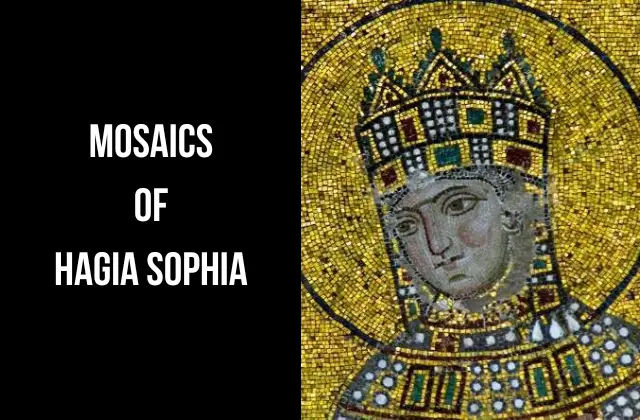
If you are traveling in Istanbul, do not go back without seeing the Galata Tower and Maiden’s Tower. Also, our articles on the Istanbul Metro Map and Istanbul City Transportation Card will be useful for you to travel comfortably in Istanbul.
Mosaics of Hagia Sophia FAQ
What is the significance of the Deesis Mosaic in Hagia Sophia?
The Deesis Mosaic in Hagia Sophia is a profound representation of the final judgment, featuring Christ Pantocrator, the Virgin Mary, and John the Baptist. It symbolizes Christ’s role as the Almighty and the intercessors’ plea for mercy on humanity’s behalf.
Who are the intercessors depicted in the Deesis Mosaic?
The intercessors in the Deesis Mosaic are the Virgin Mary and John the Baptist. They are shown praying to Christ Pantocrator, acting as intermediaries between humanity and the divine, asking for mercy and forgiveness.
What is the story behind the mosaic featuring Emperor Constantine IX and Empress Zoe?
The mosaic of Emperor Constantine IX Monomachos and Empress Zoe hints at the complexities of their love story and the intrigues of Byzantine court politics. Some historians believe that the face of Constantine IX was altered to resemble Zoe’s subsequent husband, revealing the intricate dynamics of the imperial court.
How do the mosaics in Hagia Sophia reflect the intertwining of faith and power in the Byzantine Empire?
The mosaics in Hagia Sophia often depict emperors in acts of religious devotion, underscoring the connection between faith and imperial rule. They highlight how Byzantine emperors saw themselves as both political leaders and spiritual figures, embodying the fusion of faith and power.
What is the message conveyed by the mosaic of the Virgin Mary and the infant Jesus in Hagia Sophia’s apse?
The mosaic of the Virgin Mary and the infant Jesus in the apse of Hagia Sophia represents a pivotal moment in Byzantine history. It symbolizes the triumph of the Iconophiles, who advocated for religious images, over the Iconoclasts, who opposed them, marking the restoration of the veneration of religious images in the empire.
Who is depicted in the mosaic above Hagia Sophia’s imperial gate?
The mosaic above Hagia Sophia’s imperial gate depicts Emperor Leo VI the Wise, praying to Jesus, flanked by Mary and the Archangel Gabriel.
What is the central theme of the mosaic featuring Emperor Justinian and Empress Theodora?
The central theme of the mosaic featuring Emperor Justinian and Empress Theodora is their imperial authority and influence in the Byzantine Empire.
What is the significance of the Seraphim Angels mosaic in Hagia Sophia?
The Seraphim Angels mosaic in Hagia Sophia is believed to be the celestial protectors of Constantinople, safeguarding the city from countless sieges throughout its history.
Why is the mosaic of the Virgin and Child in the apse of Hagia Sophia important?
The mosaic of the Virgin and Child in the apse of Hagia Sophia symbolizes the triumph of the Iconophiles over the Iconoclasts, marking the restoration of religious images in the Byzantine Empire.
Read More…

